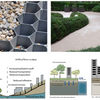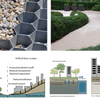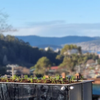Rethinking Roof Gardens: How Self Watering and Wicking Beds Unlock More Planting Diversity

Rethinking Roof Gardens: How Wicking Unlocks More Planting Diversity
Rooftop gardens are no longer just an architectural feature — they are becoming an essential part of urban greening, climate resilience, and biophilic design. But while the benefits of roof gardens are well known — reduced heat island effect, improved stormwater management, and enhanced wellbeing — the practicalities of soil depth, weight, and irrigation often limit what can be achieved.
At WaterUps, we believe the next evolution of rooftop planting lies in harnessing wicking technology, and our new Mini Sub Irrigation Channel (Mini SIC) is designed specifically for this challenge.
The Challenges of Roof Gardens
1. Soil Depth Restrictions
Structural load limits mean most roof gardens are built with shallow soil profiles — often less than 200mm. This restricts plant choices to hardy groundcovers and shallow-rooted species, limiting biodiversity. While some designers use raised garden beds or self watering raised garden beds to increase depth, many still face challenges with weight and moisture retention.
2. Weight Considerations
Deep soil profiles can support shrubs and even small trees, but the additional weight of both the soil and retained water can exceed building engineering tolerances. This makes lightweight growing media a necessity — but such media dries out rapidly. By contrast, wicking beds and self watering planters can hold moisture efficiently at the base, allowing for healthier growth without excessive load.
3. Water Management
Traditional irrigation on rooftops relies on drip lines or spray systems. These lead to high evaporation losses, uneven wetting, and frequent maintenance. In shallow profiles, water often drains too quickly, stressing plants during hot, dry periods. Incorporating wicking garden beds or self watering garden beds can reduce this stress by ensuring consistent water availability through sub-surface wicking.
Current Practices
To overcome these challenges, many roof garden designs use:
-
Lightweight soils with high drainage capacity to reduce weight
-
Geotextile mats or drainage cells to manage water flow
-
Automated surface irrigation to supply frequent, small amounts of water
While functional, these approaches often leave plants vulnerable to stress, restrict species diversity, and require high ongoing maintenance.
Introducing the WaterUps Mini SIC
The Mini Sub Irrigation Channel (Mini SIC) is a compact, modular wicking insert designed for shallow growing profiles such as rooftop planters. By creating a perched water table at the base of the soil, the Mini SIC ensures consistent moisture availability while minimising weight load.
Key Benefits for Landscape Architects:
Greater Planting Diversity
With consistent sub-surface moisture, designers are no longer restricted to just groundcovers. Shrubs, grasses, and a wider range of ornamental species can thrive in shallow profiles and raised beds.
Reduced Weight Burden
Because water is stored efficiently at the base rather than saturating the entire soil profile, overall weight is reduced compared to traditional methods. This makes it suitable for self watering planters, wicking pots, and raised garden beds on rooftops.
Lower Maintenance
Less frequent watering is required, reducing reliance on complex irrigation systems and lowering operational costs.
Climate Resilience
Wicking protects plants from both drying out and waterlogging, ensuring healthier growth in the extreme rooftop environment.
Scalability
Mini SIC units can be installed across small planters, podium landscapes, or large-scale rooftop green infrastructure projects.
Why This Matters
By integrating the Mini SIC into rooftop designs, landscape architects can:
-
Push the boundaries of planting palettes
-
Deliver greener, more biodiverse rooftops
-
Reduce engineering and maintenance challenges
-
Align projects with Water Sensitive Urban Design (WSUD) principles
When used within wicking beds or self watering garden beds, the Mini SIC creates ideal conditions for a wide range of plant types while maintaining low water use.
A Greener Future Above the City
Roof gardens are vital to the future of sustainable urban design. With innovations like the WaterUps Mini SIC, we can move beyond today’s limitations and create rooftops that are not only beautiful but resilient, diverse, and climate-smart.
At WaterUps, we’re excited to work with designers and developers to bring this next generation of rooftop greening to life — whether it’s through wicking garden beds, raised beds, self watering planters, or wicking pots that redefine how we grow above the city.








